Lake Annecy, the mountains, nature: our environment is a dream! With the current health crisis, more and more people need to get fresh air and escape to the mountains to regenerate and this is quite normal. This unfortunately results in over-frequentation of certain places and drifts in the practices of bivouac and wild camping. The objective of this article is to take stock of the regulations, mountain habits and customs and the rules of good behavior to be followed in bivouac in order to respect the environment and the humans who live and occupy these places all year round.
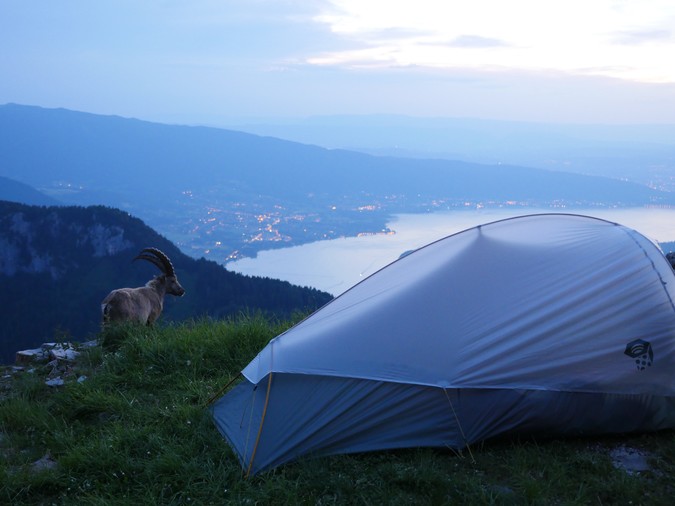
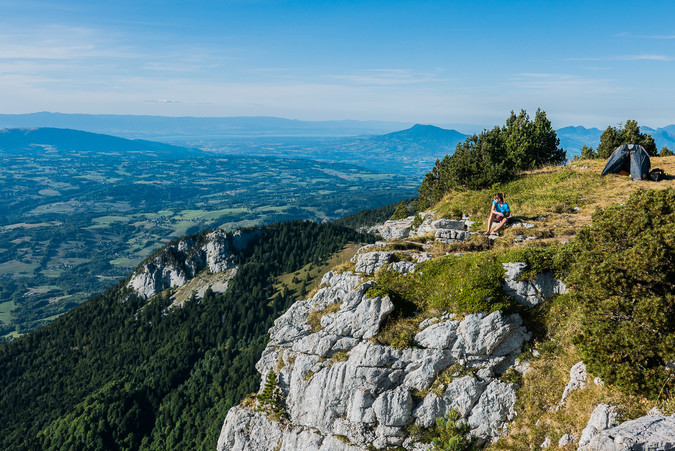
What is the bivouac?
The bivouac has several definitions / interpretations. As part of our mountain practices (hiking, trekking, mountaineering) it will be considered as a light and temporary camp to spend the night in the middle of nature. The notions of light and temporary are essential and differentiates it from wild camping, which is a camp for several days in the same place. The bivouac is therefore often practiced under the stars or in a light tent for a single night in a natural place away from civilization.
What does French law say?
There is no decree specific to the bivouac. French law does not distinguish between bivouac and wild camping. The two practices are confused in that of camping.
In France, the regulations on camping are defined in Decree No. 2015-1783 of December 28, 2015 relating to the regulatory part of Book I of the Town Planning Code and the modernization of the content of the local town planning plan.
In summary, this decree stipulates that:
- Camping can be practiced freely, off the roads, public roads with the agreement of the person who has the use of the land, subject, if necessary, to the opposition of the owner.
- Camping in isolation (including wild camping or bivouac) is prohibited, except for exceptions:
- On the shores of the sea and in the inscribed sites.
- In classified or pending sites.
- In the safeguarded sectors, in the field of visibility of buildings classified as historical monuments and of parks and gardens classified or registered and having been the subject of a protection perimeter, as well as in areas of development of the architecture and heritage or, where they exist, in the architectural, urban and landscape heritage protection zones.
- Within a radius of 200 meters around the water points collected for consumption.
3. The practice of camping outside developed sites may be prohibited in certain areas:
- By the local urban plan (PLU), or by the town planning document in lieu thereof.
- By order of the mayor
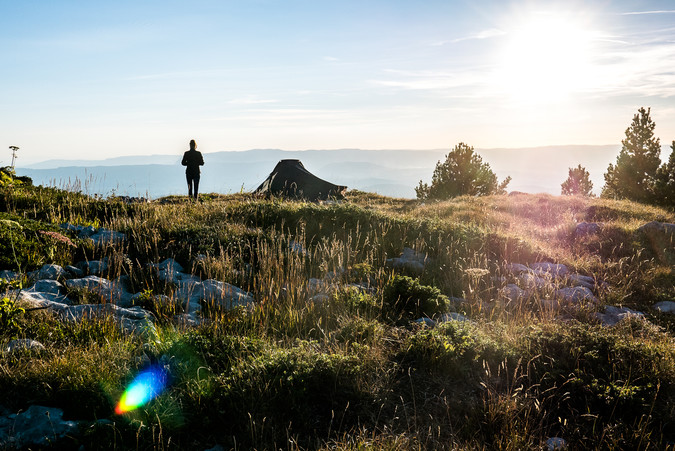
Where to bivouac around Lake Annecy?
Protected natural areas
The territory around Lake Annecy includes protected natural areas with specific regulations prohibiting bivouacs:
National nature reserves
National nature reserves are among the most protected and regulated areas in France, just behind the heart of national parks.
Around Lake Annecy we have two reserves:
- The Roc de Chère reserve
- The reserve at the end of the lake which includes a lake protection area
The Bauges national hunting and wildlife reserve
This remarkable site, an integral part of the PNR des Bauges, is located in the “Hautes-Bauges” section. It is co-managed by three organizations (the ONF, the ONCFS and the PNR des Bauges). The reserve was created in 1913 with the aim of maintaining the then declining chamois population.
The interdepartmental decree that applies there prohibits camping and bivouacs in a natural environment that is not justified by a vital emergency.
The other natural spaces
Apart from the protected natural areas where bivouacs are strictly prohibited, around Lake Annecy there are natural sites qualified as Natura 2000 or ZNIEFF where the regulations are less strict and allow bivouacs under the guise of respecting nature. In these spaces you can set up your tent for the night, provided that you respect the points mentioned in paragraph B.
Alpine pastures and private areas
The specificity of the area around Lake Annecy is its strong anthropization. Near the lake, the bivouac is difficult to imagine because you will very often be on private land. More in the mountains you will encounter the problem of mountain pastures. In summer, many herds (cows, sheep, goats) are in the pastures and occupy the pastures. Avoid setting up your bivouac in the middle of the mountain pastures, choose a space away from the enclosure where the animals graze.
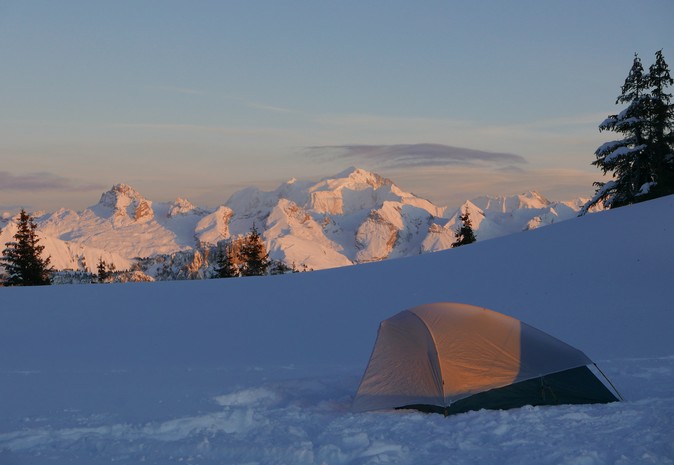
Rules and practices in bivouac
Camping and hiking in the great outdoors, and especially in the mountains, is something that is not trivial and that it is best to prepare. Here are the main rules to follow in order to create a bivouac experience that respects the environment and yourself:
Plan your bivouac and get ready
This will allow you to ensure your safety and anticipate your experience in the field. Here are the points that you should study before your bivouac
- Your physical preparation
- Your bivouac equipment
- Water is a rare element in the mountains around Lake Annecy, provide enough water to be self-sufficient or identify sources on your route. The website https://www.refuges.info/ lists the huts and springs by massif. If you drink spring water, be sure to purify it.
- The route
- Many GPS applications exist on phones (Iphigénie, Outdooractive, IGN Rando etc.) and allow you to plan your route.
- The 1: 25000 map and compass are still the safest elements to orient you in the field because they work even after a battery failure.
- The regulations specific to your practice area (refer to the IGN maps on the Geoportal which lists the protected natural areas), contact the town hall or the park where you will be operating if necessary.
- Weather : Visit the Météo France website
- Emergency number > European emergency number: 112
Stay on the trails and camp on the identified bivouac sites
The over-frequentation of mountain trails has a very strong impact on the ground, the same goes for the bivouac areas. Depending on the cover (vegetation, rock, snow), it will be more or less deteriorated in the long term by the repeated passage of walkers. It is therefore very important to leave as little as possible the trails already created and to camp on the already tested spots in order to limit erosion.
Eliminate and lower your waste
In the mountains, there are no garbage cans or toilets. The question then arises of the management of our waste.
- Provide garbage bags to bring back all your plastic and food waste.
- Human waste is polluting. It is important to remove them in order to avoid pollution of water sources. As far as possible, solid waste should be buried away from a place of passage and a watercourse. The used toilet paper must not be left on site but brought back in a plastic bag. For more details visit this article from Montagnes Magazine.
When you have to wash or do the dishes, do not do it directly in the lake or stream because you will pollute it. Do it remotely with small amounts of biodegradable soap.
Leave what you find
Don't you dream of the first man-made explorations where everything was virgin and yet to be discovered? In the spirit of conserving the environment as well as possible so that everyone feels like a pioneer, leave stones, plants and other objects in their natural environment, avoid introducing or transporting non-native species.
The campfire
It is true that fire brings a warm and magical dimension to our vigils in the heart of nature, but it has lasting destructive effects on the ground over decades as well as on the environment (risk of fire). It is to be avoided in certain sectors (in particular the south of France) and according to the level of risk of forest fire.
In France, the legislation is clear with regard to fires: Article L. 131-1 of the Forest Code prohibits any person other than the owner of land, wooded or not, or other than the occupants of these lands on the part of the their owner, to bring or light fire on these lands and up to a distance of 200 meters from woods and forests.
When the fire is authorized, do so in dedicated locations or on old fireplaces. Do not cut live trees (green wood does not burn) but use dead wood on the ground. Do not surround the fireplace with stones which could explode under the effect of the heat.
Respect the environment
Observe wildlife from a distance, do not feed them as this can be harmful to their health, it can modify their behavior and expose them to predators and other dangers.
If you walk with your dog, do not let him wander and disturb wildlife, in sensitive areas avoid taking him with you or keep him on a leash.
Avoid approaching wildlife during sensitive periods: rut, nesting, rearing young, in winter.
Respect others
The mountain does not belong to you, respect others, be courteous to other hikers, the one who climbs generally has priority, do not camp just near another camp, avoid noise pollution and enjoy the harmony of nature sounds.
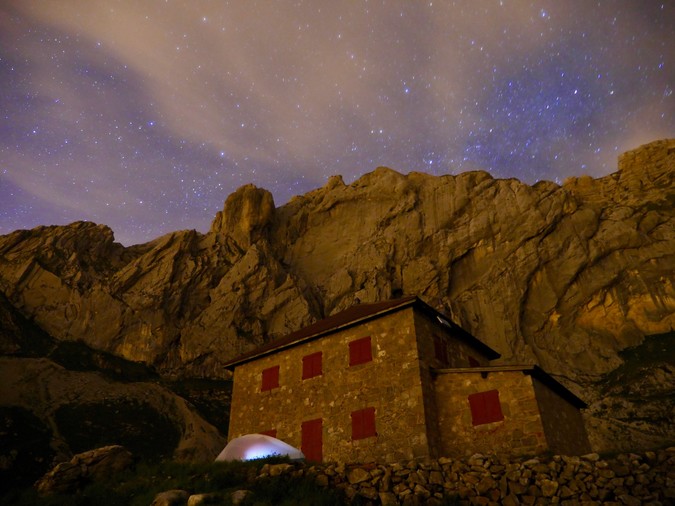
Experience the bivouac in summer or even in winter under the supervision of mountain professionals
Author : Lauris Chaumond
Photos : Lauris Chaumond et Jérémy Janody

